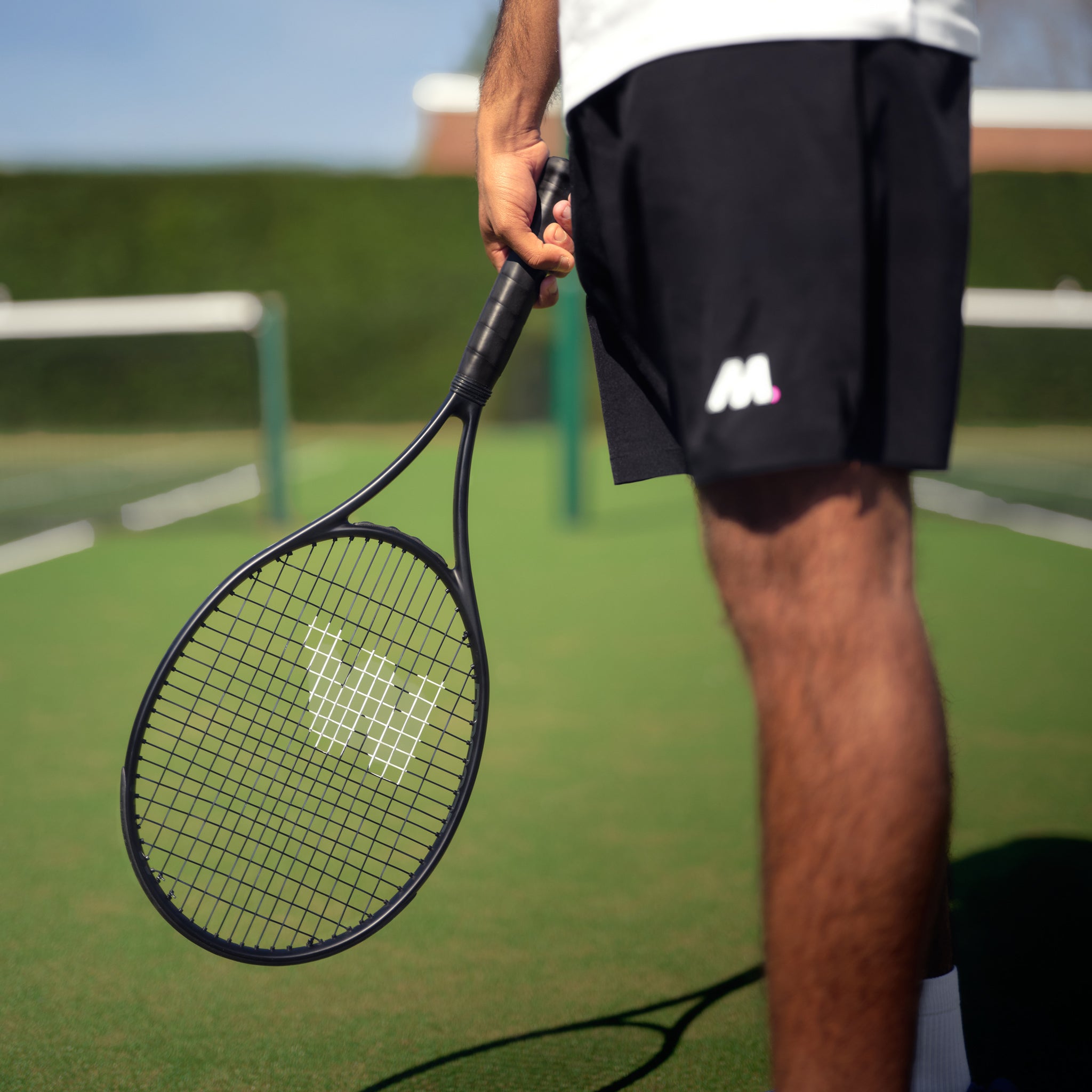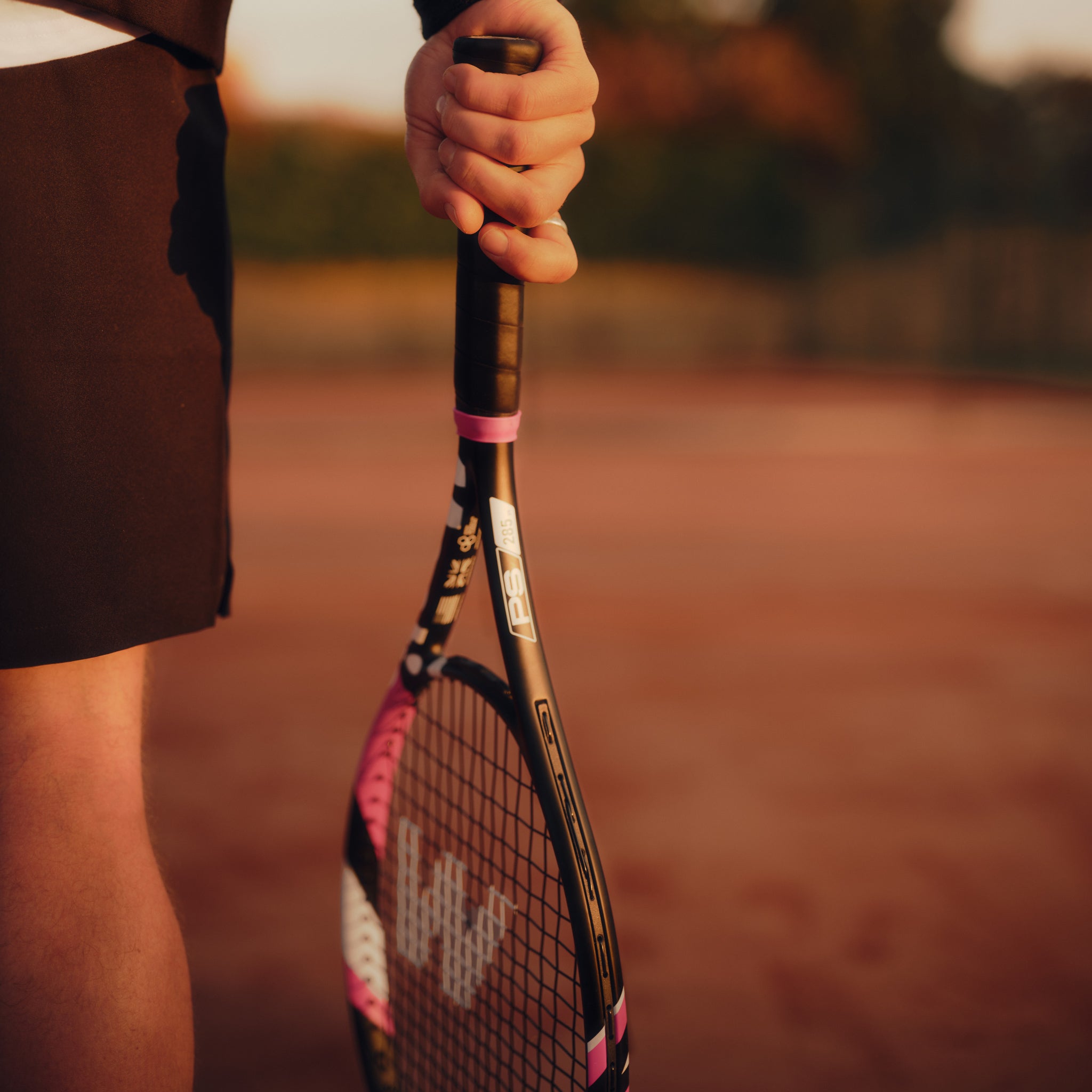
When you're sorting out your racket, the first thing to get right is the handle. This is where the whole overgrip vs replacement grip conversation starts, and it’s simpler than it sounds. At its core, a replacement grip is the essential, padded foundation that wraps directly onto the bare handle of your racket. An overgrip, on the other hand, is a much thinner, optional layer you add on top to fine-tune the feel and performance. We have a detailed guide on how to grip a tennis racket that can help.
Every racket needs a replacement grip. Not every player needs an overgrip.
The Fundamental Role of Each Grip Type when considering an overgrip vs replacement grip
Think of the replacement grip as the permanent base layer of your handle. It’s what provides the primary cushioning, absorbs the initial shock from impact, and ultimately defines the handle’s size and shape. At Mantis, we see it as part of the racket's core structure. For a detailed walkthrough on fitting one, check out our guide on how to grip a tennis racket.
An overgrip is all about personal preference and tactics. It's a thin film wrapped over the replacement grip to add extra tackiness for a stickier hold or to soak up sweat if you're playing in the heat. It’s a performance enhancer, not a structural necessity.
This is the key takeaway: a replacement grip is semi-permanent and you only change it when it’s truly worn out. An overgrip is a consumable. It’s designed to be peeled off and replaced often—sometimes after just a few tough matches—to keep your racket feeling fresh and performing at its best.
To make things crystal clear, here’s a quick breakdown of the main differences before we get into the finer details.
Key Distinctions at a Glance
This table offers a simple, at-a-glance summary of how these two grips differ in function and application.
| Characteristic | Replacement Grip | Overgrip |
|---|---|---|
| Primary Function | Provides essential cushioning and forms the base handle. | Customises feel, improves tackiness, and absorbs sweat. |
| Application | Applied directly onto the bare racket handle. | Wrapped on top of the existing replacement grip. |
| Thickness | Thicker, providing substantial padding (1.5mm - 2.5mm). | Thinner, for feel and minimal size increase (0.4mm - 0.75mm). |
| Lifespan | Long-term; changed infrequently (e.g., once a year). | Short-term; changed frequently (every few matches/weeks). |
| Necessity | Mandatory for all rackets. | Optional based on player preference. |
Essentially, one is the foundation, and the other is the finish. Now, let’s look at how these differences play out on the court.
How Grips Actually Feel in Your Hand
Beyond just being a foundation or a top layer, the real difference between an overgrip and a replacement grip comes down to how they feel on court. The materials, thickness, and texture all come together to define your connection to the racket, which in turn affects your control, comfort, and confidence. Getting this right is a small detail that makes a huge difference.
A replacement grip is built to last. It’s the bedrock of your handle, usually made from synthetic leather or advanced polymers that provide a cushioned, stable foundation. These materials are chosen for their resilience and ability to soak up shock over countless hours of play.
Overgrips, on the other hand, are all about short-term tactical advantage. Their materials are chosen for specific jobs, like providing a sticky, tacky feel or a dry, cloth-like texture for maximum sweat absorption. They wear out fast, but they let you fine-tune your racket’s feel for any given day or condition.
Materials and Texture: A Direct Comparison
The stuff a grip is made of directly dictates how it feels. Replacement grips usually have a firmer, more cushioned feel, sometimes with subtle perforations for breathability or faint ridges for a secure hold. Their texture is designed for long-lasting comfort, not aggressive stickiness.
Overgrips are where you find all the variety:
- Tacky Grips: These have a slightly adhesive surface that almost glues the racket to your hand, which is brilliant for stopping it from twisting on off-centre shots.
- Dry Grips: Made to absorb as much sweat as possible, these feel more like fabric. They’re a lifesaver for players in humid climates or anyone with naturally sweaty palms.
- Contoured Grips: Some overgrips even have raised ridges that give your fingers extra traction and a more defined feel of the handle.
This image breaks down the key performance differences between the two grip types.

As you can see, while replacement grips win on thickness and durability, overgrips are the clear champions for sweat absorption—proving their role as a true performance layer.
Thickness and Feeling the Bevels
Thickness is a massive factor in the overgrip vs replacement grip debate. A standard replacement grip is pretty chunky, usually between 1.5mm and 2.5mm. This adds noticeable size and cushioning to the handle, which also has the effect of softening the sharp edges of the racket’s bevels.
An overgrip, in contrast, is incredibly thin—around 0.4mm to 0.75mm—so it only slightly builds up the handle size. Its main purpose is to tweak the feel without burying the racket's original shape, allowing you to still feel the bevels for better racket angle awareness and control.
A Practical Guide to Grip Installation and Care
Knowing the difference between an overgrip and a replacement grip is one thing, but getting them on your racket correctly is where it really counts. Proper installation is what gives you the feel, performance, and durability you’re looking for.
Before you start wrapping, though, the first step is always to confirm your handle size is right. Get that wrong, and no grip in the world will feel comfortable. You can learn more by measuring tennis grip size to build your setup on the perfect foundation.
Applying a new replacement grip is a bigger, less frequent job. It involves stripping everything off—the old grip, any lingering tape, and sticky residue—until you’re down to the bare handle. From there, you wrap the new grip carefully from the butt cap up, making sure the overlap and tension are consistent to avoid any lumps or gaps. The result is a seamless, cushioned base for your hand.
Applying an Overgrip
Putting on an overgrip is much quicker and simpler, and that’s entirely by design. Since they’re meant to be changed often, you can get a fresh one on in just a few minutes.
- Start at the Bottom: Begin wrapping at the butt cap of the racket, right over your existing replacement grip.
- Maintain Tension: Keep the wrap firm but not stretched, overlapping each layer by a few millimetres for a smooth finish.
- Finish Securely: When you reach the top of the handle, snip the excess grip at an angle and use the finishing tape that comes with it to lock it in place.
This straightforward process means players can keep that fresh, tacky feel without any real downtime.
When Should You Change Your Grip?
Knowing when to refresh your grip is key to playing your best. The guidelines for each type are quite different, reflecting their intended use.
A good rule of thumb for overgrips is to change them as often as you change your strings. For a replacement grip, think about swapping it once it feels compressed, looks visibly worn, or has lost its cushioning—typically once or twice a year for most club players.
Obvious signs of wear, a slick surface where there used to be tack, or a grip that no longer soaks up sweat are all clear signals it’s time for a change. If you’re playing in humid conditions or hitting for hours on end, that time will come much sooner. A competitive player might change their overgrip every few matches, while a casual player might find it lasts a month or more.
How Your Grip Choice Really Affects Your Game
The link between your grip and how you play isn't just a minor detail—it’s everything. It directly shapes your power, your precision, and your overall confidence on the court. Here at Mantis, we know this choice goes far beyond simple comfort. It's about finding your competitive edge.
Let's break down the practical differences between an overgrip and a replacement grip, because each one serves a very different purpose when the match is on the line.
A replacement grip is your first line of defence against fatigue and shock. Its thicker, cushioned build is designed to absorb the harsh vibrations that travel up your arm with every shot. This is crucial during long, punishing rallies or five-set battles, helping to reduce arm strain and fend off injuries like tennis elbow. If your replacement grip is worn out, that cushioning disappears, leading to discomfort and sloppy, inconsistent shots.
On the other hand, an overgrip is all about feel, control, and confidence.
Fine-Tuning Your Feel with Tackiness and Sweat Control
The main job of an overgrip is to deliver that tacky, secure feeling and absorb moisture, stopping the racket from twisting in your hand at a critical moment. A fresh, sticky overgrip gives you an unwavering hold, which lets you swing more freely and place the ball exactly where you want it. This is a game-changer in humid conditions where a standard grip can quickly become dangerously slick with sweat.
Player habits in the UK really highlight these different roles. A good replacement grip is built for durability and might only be changed once a season for the average player, usually after around 20-30 hours of play. Yet, feedback from UK tennis players and coaches reveals that a massive 70% of recreational players rely on overgrips, often swapping them out up to four times a season to keep their feel and performance sharp.
Think about it in a real-world match: you’re deep in a third-set tiebreak on a hot day. A worn, slippery grip could cause your racket to turn ever so slightly on a crucial volley, sending the ball wide. A fresh overgrip, however, gives you that rock-solid connection needed to execute the shot with total precision.
At the end of the day, your replacement grip provides the foundational comfort to help you endure, while the overgrip offers the tactical feel you need to perform at your peak.
Cost and Value Analysis for Players
When you're weighing up overgrips versus replacement grips, cost is always part of the conversation. But it’s not just about the price on the tag. It’s about long-term value and what makes sense for how often you actually get out on court.
A single replacement grip feels like a bigger investment up front, usually setting you back somewhere between £7 and £15. For most club players who only change their base grip once or twice a year, that annual cost is pretty easy to swallow.
Overgrips, on the other hand, are much cheaper per unit. You can often grab a multi-pack for just a few quid, making them a really accessible way to freshen up your handle whenever you feel the need.
Comparing Long-Term Expenditure
The true cost only really becomes clear over time, and it’s completely tied to your playing habits. If you’re a casual player, one replacement grip might see you through an entire season, making it a brilliant, cost-effective choice.
But a serious competitive player will be swapping out their overgrip every few matches to keep that tacky, fresh feel. Each one is cheap, but those costs add up. Over the course of a year, you could easily spend more on overgrips than you would on a single replacement grip.
The core of the value analysis is this: are you paying for longevity and foundational comfort (replacement grip) or for frequent, peak-performance customisation (overgrip)? Each serves a different financial and practical purpose.
Finding the Best Value for Your Game
Ultimately, the best value isn't just about finding the cheapest option. It’s about what supports your game without breaking the bank. There's a reason the global tennis overgrip market is booming, projected to hit $164.57 million by 2032. Players love them. Here in the UK, their convenience and ability to handle our unpredictable weather make them a go-to for players at every level.
For most players, the smartest financial strategy is a hybrid one. Invest in a quality replacement grip as your long-term base, then use affordable overgrips for regular maintenance. It’s the best of both worlds, giving you durable comfort and that consistent, top-level performance feel every time you play.
Your Top Grip Questions, Answered
To wrap things up, let’s tackle some of the most common questions players have about grips. At Mantis, we want to give you clear, practical answers that build on what we’ve covered, helping you make the best choice for your racket and your game.
Can I Use an Overgrip Without a Replacement Grip?
Absolutely not. This is one of the most critical distinctions to understand, and it's a mistake you don't want to make. The replacement grip is the essential foundation, providing the cushioning and structure your hand needs on the bare racket handle.
Putting an overgrip directly onto the pallet would feel harsh and uncomfortable, with almost no shock absorption. You’d feel the sharp edges of the handle’s bevels, which could easily lead to hand fatigue or even injury. Overgrips are designed to go over a replacement grip, never in place of one.
How Do I Know When to Change My Grip?
Knowing the right time for a change is key to keeping your connection with the racket strong. The signs are a bit different for each type.
- For an overgrip: The moment it loses its tackiness, looks visibly dirty, or stops absorbing sweat, it’s done. If you play regularly, this could be every few weeks.
- For a replacement grip: You’ll want to change this when it feels overly compressed, starts to unravel, or has clearly lost its cushioning. For most club players, this is usually once or twice a year.
The most important signal is always the feel. If the grip feels slick, hard, or just plain wrong in your hand, it’s time for a change. A fresh grip is a simple but massive boost to your confidence and control.
The demand for these accessories is huge. In the UK, the tennis equipment market is a key part of the broader European market, which was valued at $143.558 million. With the UK accounting for roughly 13.32% of this, our racket-related market contributes around $19 million—a figure that highlights just how much players value quality gear.
Does an Overgrip Make My Handle Size Bigger?
Yes, but only slightly. Standard overgrips are incredibly thin, usually between 0.4mm and 0.75mm. This tiny increase adds about half a grip size to the handle’s circumference.
It’s actually a very popular and effective way for players to fine-tune their grip for a more secure and comfortable hold, without fundamentally changing the handle's shape. If you need a more significant size increase, you’d be looking at a thicker replacement grip or a specialised heat-shrink sleeve.
At Mantis, we are dedicated to providing expertly crafted equipment for players who live for the game. Explore our range of high-performance tennis gear at https://mantissport.com.








